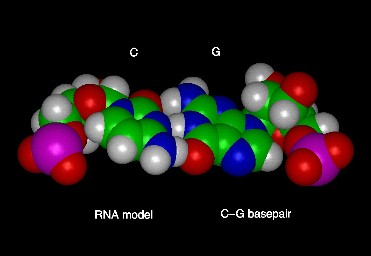| For many, evolution is seen as a natural progression
from the simple to the complex. Man is seen as the ultimate pinnacle of complexity,
capping four billion years of slow and steady evolutionary progress. In reverse, this concept
implies that as one moves backward, closer and closer to the original forms life, things
would become increasingly simple. The experiments of Miller and others are seen as
identifying the
first step in moving off the floor of inorganic chemistry climbing a stairway toward life
- a stairway that eventually leads through the various forms up to the high heavens wherein resides
Man. Although the leading authorities in the field have been trying to move away from this
concept (and its obvious philosophic overtones) for years, to the popular press and many who do not
have a special interest in this issue, this idea of stepwise increasing complexity
is the story of evolution.
Ernst Haeckel, who lived at the same time as Darwin,
postulated that the
cell was simply a "homogeneous globule of protoplasm". In the view
of those early Darwinists,
given the available scientific knowledge of the time, cells could easily be
envisioned as something very
simple, as though they were only a few steps up off the inorganic floor. It was easy for them to
imagine how such a shapeless blob of goo might have spontaneously come into
its very simple existence as a living creature. However, the early Darwinist
view that life could easily arise from random mixtures of organic compounds
into simple living cells has been dashed against a wall of biotic
complexity. |
 |
|
|
Indeed, there is a
wall of complexity - a steep curve which comes in at levels far below that of
a complete and whole
self-reproductive life form. There is incredible complexity in the intricacy of
the most basic sub-life building blocks like DNA,
RNA and proteins. It is exactly this wall of complexity that makes
describing a spontaneous natural origin of life so very difficult. In the first 100 years after "Origin of Species" was
published, science found the most simple living cell was far too complex to have come into existence
on its own and without any predecessors, so theories of spontaneous whole-cell origins
died, and scientists began to develop various sub-cellular theories of how the building
blocks of the cell (such as proteins) could have come together to form useful
"systems" which later evolved into cellular life. Because they accomplish the
"work" of the cell, proteins were first seen as the initial step on the
sub-cellular road to life. Decades ago, proteins were seen as simple combinations of amino
acids with little knowledge about their shape or orientation. However, beginning about 40
years ago, scientists began to turn the then new technology of the day toward the study of
proteins. What they found was that the proteins of life are highly complex and twisted
three dimensional structures where the shape, orientation and the sequences of the amino
acids have a great effect on how the proteins act and react. This discovery of the complex,
folded 3 dimensional nature of proteins, basically forced scientists from
protein-first theories to the RNA world concept in hopes of seeking a
self-replicating system to account for the overwhelming complexity found in
life proteins and other basic building blocks of life. |
Apart from a
Designer or Creator, evolution is the only possible process which can account for this
complexity and organization. Since natural selection can only function in
self-reproductive systems, and both DNA and proteins are poor candidates for
self-reproductive systems, only RNA is left. But as I mentioned in the RNA world
section above, RNA is not necessarily a good candidate
for a self-reproductive system. Robert Shapiro and other researchers have stated a
that because of RNA's low catalytic potential (it was only in the late 80's that we
discovered an RNA structure that had any catalytic potential), the existence of a
self-reproductive RNA is highly unlikely. The failure to find any self-reproductive RNA
systems and the shift of researchers to other "simpler" systems such as PNA,
provide silent testimony that the RNA world theory may also be hitting the
"pre-biotic wall of complexity" that the protein-first theories fatally collided
with a bit more than a decade ago. What can account for the complexity of basic life
building blocks such as proteins, DNA and RNA? Unless a self-reproductive system can be
found, it cannot be evolution or natural selection - for without some form of
self-reproduction they cannot accomplish any movement or evolution toward
life. One suggestion that recently attracted considerable
attention is the idea that all organic materials posses some sort of inherent
but as yet undiscovered "self-organizational" property that binds them together into useful forms. We
will examine that claim next. |